When it comes to cooking, I definitely have weaknesses. I’ve never cooked a perfect roast chicken. I can’t cook a steak with any sort of precision in doneness; if it’s somewhere between ‘moo’ and black, I consider it a success. And grilling? I’ve really never done it. Clearly there are holes in my culinary knowledge.
But pizza? Pizza, I know.
I make pizza almost every week. I’ve tried all sorts of crusts, sauces, cheeses, and toppings. I’ve taken notes. And now, finally, I can make my perfect pizza. I’m not saying that my favorite will be your favorite; but it might give you somewhere to start and something new to try.
Toppings – I’m going to attack this from top to bottom, which has the advantage of progressing from the simplest decisions to the more complicated. I’m going to focus on traditional pizza – tomato sauce, Italian cheeses, toppings. Most any topping will work here. Use whatever toppings you want in whatever quantities you prefer. I vary it quite a bit, with my favorite combinations being ham and mushroom, as well as ham and pineapple.
Cheeses – I like a ratio of 5 parts mozzarella to 1 part parmesan. If you have other cheeses around, cheddar or gouda or fontina, it can be fun to replace a portion of the mozzarella with those. I actually prefer part-skim mozzarella on pizza; it seems to melt more smoothly and it tastes just as good as whole milk cheese.
Sauce – My sauce is very (very very) simple, but you have to trust me that it’s just right. All I do is puree a drained can of diced tomatoes, strain them until they’re thick, then stir in salt and pepper. It’s easier than cooking a sauce, and I love the fresh flavor. It does complicate the addition of garlic and spices, but I get around that by adding the garlic as a topping and the herbs to the crust. (I don’t like raw garlic, so I toast the whole unpeeled cloves on the hot pizza stone for a few minutes.)
Crust – I want a crust that is light and tender and flavorful, but, even more importantly, easy to work with. No one wants to fight with their pizza dough. This crust started with Cooks Illustrated’s popular pizza dough recipe, and then I started substituting white wine for a portion of the water, and after I made Peter Reinhart’s pizza dough, I became more committed to a cold overnight rise.
Another important aspect of pizza crust is how you work with it. Be gentle with your dough. I need to stress that you really don’t want to use a rolling pin. Pull and stretch the dough. Pick it up, hanging the edges on your knuckles, and let gravity do the work. If it’s tearing or thinning unevenly, put it back down and just pull at the thicker parts. If it’s fighting you, walk away for five minutes to let it relax. (I use this technique when I fight with Dave too – ha!)
I’m sorry to be so braggy, but this pizza really is just great. Most of it comes down to the crust, which is thin, crisp, and light. I love the sauce too, because it tastes exactly like what it is – tomatoes. The combination of cheeses provides just the right amount of richness and flavor. I start out nearly every weekend by making this pizza, and I can’t think of a better way.
Update 3/16/10: I’ve successfully used this method to make this pizza crust whole wheat. I made the pre-dough out of 11 ounces whole wheat flour, ¾ teaspoon salt, and 1 cup water . After letting that sit overnight, I mixed it with the rest of the ingredients – 2 tablespoons olive oil, ½ teaspoon dried oregano, 11 ounces white bread flour, 1 teaspoon salt, 2 teaspoons instant yeast, 1 teaspoon granulated sugar, ¼ cup white wine, and ½ cup water.
Printer Friendly Recipe
Traditional Pizza
You can substitute up to 7 ounces (about 1½ cups) of whole wheat flour for the white bread flour, but expect longer rising times and a more stubborn dough. But if you’re patient during shaping, your crust will be just as light and crisp as dough made completely with white flour.
Dough:
2 tablespoons olive oil
½ teaspoon dried oregano
22 ounces (4 cups) bread flour
1¾ teaspoons salt
1 teaspoon sugar
2 teaspoons instant yeast
1/4 cup white wine
1½ cups water
cornmeal for dusting
Sauce:
1 (28-ounce) can diced tomatoes, drained
salt and pepper
Assembly:
3 cloves garlic, unpeeled
10 ounces (2½ cups) part-skim mozzarella, shredded
2 ounces (1 cup) parmesan, grated
toppings of your choice
1. For the dough: Heat the oil and oregano in a small saucepan until fragrant. Mix in the water and wine.
2. In the bowl of a stand mixer fitted with the dough hook, mix the flour, salt, sugar, and yeast. With the mixer on low speed, pour in the liquid mixture. Continue mixing on medium-low speed until the dough comes together, and then knead on medium-low speed for 8 minutes, until the dough is smooth and elastic. Add more flour or water as necessary to form a dough that is sticky but does not cling to the sides of the bowl. When the mixer is running on medium-low speed, the dough should not stick to the bottom of the bowl.
3. Spray a large bowl with nonstick spray. Rub your hands on the sprayed bowl to coat them with oil, then quickly form the dough into a ball. Place the ball of dough in the bowl and cover with plastic wrap.
4. Either set the dough aside to rise at room temperature, which will take 1½ to 2 hours, or refrigerate it until the next day. If it’s chilled overnight, it will take about 5 hours at room temperature to warm and finish rising. You can also reduce the yeast to ½ teaspoon and let the dough rise on the counter for about 8 hours after it has been chilled overnight.
5. For the sauce: Pulse the tomatoes in a food processor 10-12 times, until they’re pureed. Transfer them to a fine-mesh strainer set over a large bowl and let them drain, stirring occasionally for at least 10 minutes. (You can get away with less time if you actively stir and press the tomatoes through the strainer; if you wait longer, you can stir less.) Then discard the liquid in the bowl, transfer the tomatoes from the strainer to the now-empty bowl, and stir in a pinch of pepper and 1/8 teaspoon of salt.
6. Place a pizza stone on the bottom rack of the oven and preheat the oven to 500ºF. Place the garlic on the hot pizza stone for 3-4 minutes or until fragrant.
7. Divide the dough and shape each portion into a ball. You have a few options of how to divide it. It makes enough dough for three 12-inch pizzas. However, I always cut it in half and freeze half. Then I divide the remaining dough into two more parts, one twice the size of the other. I make the larger one into pizza and the smaller into cheese bread (no sauce or toppings). Let the balls of dough relax for 10-30 minutes.
8. Using tongs, remove the garlic from the oven and let it cool for a few minutes. Mince.
9. Work with one ball of dough at a time on a lightly floured surface. Flatten the dough, then pick it up and gently stretch it out, trying to keep it as circular as possible. Curl your fingers and let the dough hang on your knuckles, moving and rotating the dough so it stretches evenly. If it tears, just piece it together. If the dough stretches too much, put it down and gently tug on the thick spots.
10. Dust a pizza peel lightly with cornmeal and transfer the round of dough to the peel. Rearrange the dough to something reasonably circular; stab it several times with a fork. Add 1/3 of each of the garlic, sauce, and cheese, followed by toppings of your preference, then transfer the pizza to a hot pizza stone. Bake for 8-10 minutes, until the cheese is bubbling and the crust is spotty brown. Let the pizza cool on the peel for about 5 minutes before slicing and serving. Repeat with the remaining ingredients.
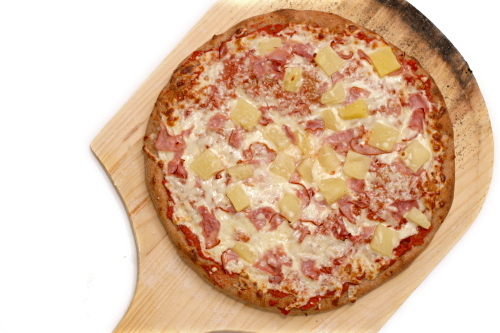
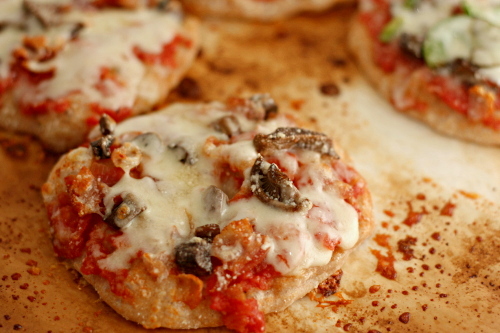

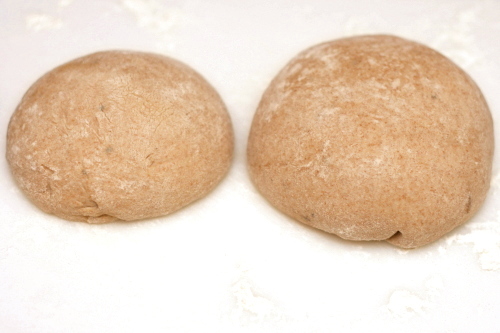
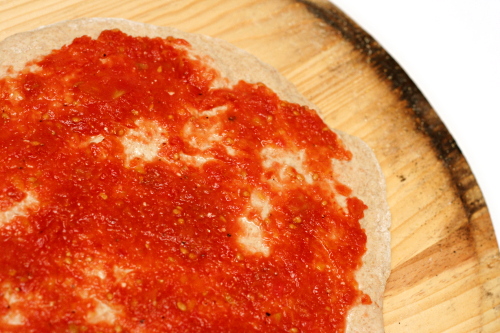
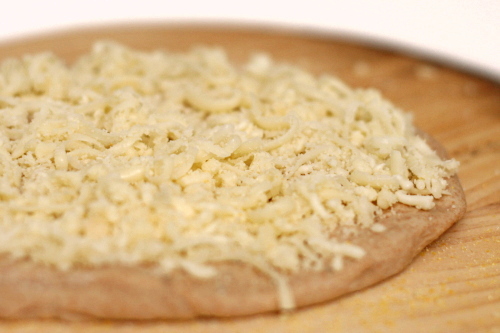
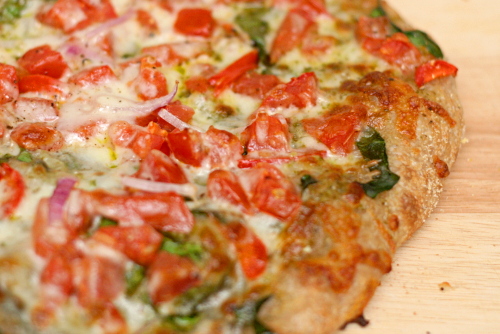
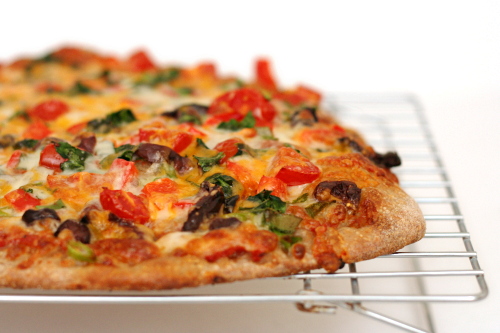







This looks amazing! I’m going to have to try the dough recipe. Have you tried using vermouth in place of the white wine? I’ve been doing that in all of my recipes after CI recommended it…..It’s easier (and cheaper) than opening a new bottle of wine.
Christine – For white cooking wine, I ignore the “don’t cook with a wine you wouldn’t drink” rule and keep of box of wine around. It’s fine for recipes where the wine is a minor part, like this one. I do sometimes use vermouth.
I love me some pizza!!!
This looks a lot like the pizzas I make. For my sauce I use the diced tomatoes with sweet onion & garlic & add some sugar and salt. Delicious! Your pictures made me hungry when I first saw them at 8am.
I’ve bookmarked this recipe. I must try this out soon.
Fantastic! I feel like I was about 1/4 of the way through the same pizza crust hunt that you were, so I think I will have to try this out and see if I can just skip to the end. However, I add garlic to the sauce AND as a topping because I like to keep vampires away. Yum.
I love these pictures! Homemade pizza is always a fun experience, each crust has it’s own personality. I am intrigued with adding white wine to the dough, if I can spare 1/4 cup!! My all time favorite pizza recipe is a Cooking Light one….. Roasted Fresh Corn, poblano, and cheddar pizza.
We made the pizza last night, and it was a HUGE hit. The hubs even admitted that he was wrong to be so down on making pizza at home rather than having it delivered. Thanks for posting, and feel free to keep on bragging about this one!
Let me tell you, I made this pizza last night and it was pretty much fool proof. I went in not knowing how to operate my stand mixer or food processor (wedding gifts) and came out with freaking awesome pizza. It was great great great. Thanks!
This was the best pizza crust recipe I have every tried! Way better than delivery, and so easy to make and to work with. I tried your idea for making cheese bread from part of the crust–my boyfriend and I loved it. Thanks so much!
This was a good recipe! I’d been trying to find one that differed enough from my standby to merit the experiment… well, this one was different, and it was great. I needed about 5 cups of flour to get the right consistency for the dough. Used about 1 1/2 cups whole wheat, and as I had no white wine (blast) I just used all water. I loved how easy it was to work with, and then it crisped up nicely on my pizza stones. My husband actually said that he preferred it to the old recipe, so I’ll be using yours from now on!
p.s. I assume that you mean “500 degrees Fahrenheit,” not “500 degrees Celsius.” 🙂
Rebekah – Uh, yeah, oops. Definitely Fahrenheit! I use Celsius at work, so I guess I’m just used to typing it! Anyway, I’m so glad the pizza came out well for you! It’s definitely great with water, but I think substituting in the extra wine gives it some extra lightness. If you try it, let me know if you notice a difference!
Thank you for sharing this recipe. I made the crust and it was amazing. Our new favorite.
Hi Bridget- I made this the other day and it was fantastic. I’ve been going through dough recipes, one by one, never really satisfied (not bubbly enough, not enough flavor, too dense) and this really hit the sweet spot. Thank you! But I have a question: You mention that you’ve been using your Tartine starter for this recipe, but I can’t find any conversion from instant yeast to starter. If you have a moment, could you tell me how your ingredient proportions change when you make this with your starter?
I’ve got my own starter that I’m dying to start using for more than bread loaves… Thanks!!!
OMG, I knew we thought similarly about food – but I knew you were my soulmate when I read your pizza-sauce-making method! Your blog has been helping me to elevate my cooking skills since I ran across it a few months ago. Thanks for all the great info!
P.S. That “fighting” technique works well with my husband too. ; )
Hi Bridget – I have a question about the whole-wheat method. After letting the pre-dough sit overnight and then mixing with the remaining ingredients, do I need to let the dough rise again (the 1.5-2 hours in step 4) or can I immediately move forward with dividing and shaping the dough? Also, if I want to make the dough ahead of time, at what point do you recommend stopping and freezing the dough? Thanks for the detailed analysis and I can’t wait to try this; the white wine addition sounds interesting!
Nevermind! I re-read the recipe and realized that the yeast is added to the remaining ingredients so it needs to rise. I’ll be trying this pizza dough this weekend.
Jean – You’re right; it will need to rise after all the ingredients are mixed. You can freeze it either right after kneading, in which case it will need to defrost and then rise before it can be shaped, or you can freeze it after it rises. If you freeze it after it rises, it will still need to defrost and then warm up to room temperature. Then divide it, shape it into balls, and let the balls rest for 10-30 minutes before stretching them for your pizzas. Enjoy!
That last picture is perfect for ending your post. I love pineapples on my pizza. yum!
Can I substitute beer for the wine?
Lexi – Definitely! It’ll be a little different, but still good.